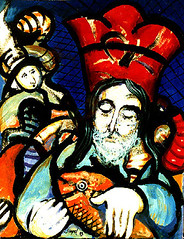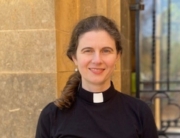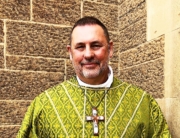
“Two kinds of love?”
A sermon by The Rev’d Wendy Morecroft
Acts 9.1-6
Revelation 5.6-14
John 21.1-19
In the name of God, who is Father, Son and Holy Spirit. Amen.
One of life’s simplest pleasures must surely be eating fish and chips at the beach at the end of a hot summer’s day. Another simple pleasure is sitting around a campfire. I don’t think I’ve ever had the pleasure of cooking fish for breakfast, on a fire at the beach, or better still, having someone else cook it for me. What an evocative image we have in today’s Gospel of Jesus cooking a breakfast of fish and bread for his disciples at the seaside. One can almost smell the fresh salt air, feel the breeze in our hair and the warmth of the fire, smell the fish sizzling and hear the waves gently crashing. We can only imagine the joy and excitement of the disciples at finding Jesus amongst them once again.
What an amazing example of hospitality Jesus gives us. Jesus doesn’t wait for his friends to call him. He reaches out to them. He finds them, provides food for them and cooks for them.
After they had finished eating breakfast, Jesus asks Peter three questions. You may recall how we heard in the Gospel on Good Friday, that Peter had denied Jesus three times leading up to his crucifixion. Jesus now asks him three times if he loves him. This affirmation of Peter’s faith is similar to what Favour Illuno will do when he is confirmed by Bp David McCall as soon as this sermon is finished.
When reading today’s Gospel, I was initially intrigued by Jesus’ responses of “feed my lambs” verses “tend by sheep”. I asked my Ancient Greek lecturer Rev’d Dr Joan Riley about the significance of those words in Ancient Greek. I’ve since learned that essentially the three responses relate to the three stages of our lives. Peter is being asked to care for Jesus’ flock when they are young, mature and elderly.
My lecturer shared with the class how much more interesting are the words for love in the Ancient Greek text. The whole class leaned in, eager to understand the deeper meaning.
Joan explained that in the first question when Jesus asks Peter, “do you love me?” Jesus uses the word “agape” for love and Peter replies using the word “philios” for love. The same happens in the second question and response. In his third question to Peter, “do you love me?” Jesus changes his word use to “philios” for love, and Peter replies with the same word “philios” adding more strongly, “Lord you know everything, you KNOW that I love you”.
Agape love in the Greek lexicon is described as “to love, value, esteem, feel or manifest generous concern for, be faithful towards; to delight in, to set store upon” another. The Theological Dictionary includes “loving without expecting it to be returned, lending where there is little hope of repayment, giving without reserve or limit. [Even harder, Agape love is accepting] the enmity of the world willingly, unresistingly and sacrificially. Doing good to those who hate us, giving blessing for cursing and praying for our persecutors. To make intercession for the hostile world, which hates God and destroys His faithful people.” Jesus twice asks Peter, “do you agape me?”
On the other hand, philios love is love of brother or sister, it is the love that would have us lay down our life for another. This is the martyr’s death that Peter was prepared to die for Christ. Jesus is also calling Peter to an unconditional love of His disciples, with a readiness for total commitment and an uncompromising renunciation of self-love.
Theologian Thomas Brodie says that Peter’s three denials are cancelled out by his three affirmations of philios love for Jesus. He says “Thus Peter is rehabilitated. But this scene, though it takes care of the past, does not dwell on it. The primary emphasis is on a testing of character which looks to the future.” Brodie considers that philios love develops from agape love. He says that agape love has “its origin in God and its example in Christ” but it moves to philios love which is “an actualisation of God in this world.” Theologian CK Barrett adds “Just as love is the inward nature of, as well as emanates from, the Godhead, so love must be the mutual relation of Christians within the church.”
However complex the definitions of love may be, today’s Gospel reminds us of The Two Great Commandments that Jesus gave us: “Hear, O Israel, the Lord our God, the Lord is one; you shall love the Lord your God with all your heart, and with all your soul, and with all your mind, and with all your strength.’ Jesus said: ‘This is the great and first commandment. And a second is like it: you shall love your neighbour as yourself.”
We have many reminders of today’s Gospel reading in the Cathedral. The most obvious is in the Lady Chapel where the three stained glass windows on the left-hand side of the altar, depict a seaside scene with Jesus, Peter, the other disciples and a flock of sheep. The words across the top say “Yea Lord thou knowest that I love thee”. At the bottom of the first window is written “Feed my lambs, then in the middle, “feed my sheep” and on the right are the last words of today’s Gospel “Follow thou me”.
This scene is depicted again, twice, in the very middle of the reredos right under the main picture of Our Lord Seated in Glory, referred to in today’s Sentence from the Book of Revelation. The first carving is of Jesus, Peter and the sheep. The scene below it is called “The Commissioning of Peter.”
Curiously, I also see this scene depicted in the painting of Peter hugging a large fish. The painting hangs near the side entrance to the Cathedral. It was painted in 1989 by William Zimpel who I have been unable to contact and also unable to find information regarding his inspiration for the painting.
However, our long-term parishioner and art buff Michael Neale provided some very interesting insights. He explained that art is as much about how the viewer interprets it, as it is about the meaning with which the painter paints it. I was talking with Michael on the phone and he was initially working from his memory.
The first thing he could recall was that Peter’s head is slightly tilted, indicating love. He considered that the curve of Peter’s hat matching the curve of the fish’s body represented his crowning over the fish. Peter loving the fish is representative of his love for the church. It is his crowning glory to love God’s people, to be a fisher of people. If we look closely at the bluish/purple background, there is a net and so what looks like the sky, is actually the sea. In this light, this somewhat unusual depiction of Peter, reminds us to love God’s people as Peter was called to do.
As Favour now affirms his confirmation vows, may he, together with Peter and all we disciples of Christ, hear anew, Jesus’ request for commitment to love God, to love one another and to follow him.



